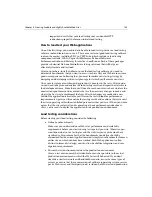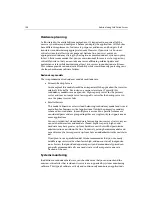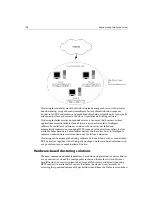
142
Administering ColdFusion Server
•
Derfler, Frank and Steve Rigney. “TCP/IP, A Survival Guide for Users.” New York,
New York: A Division of Henry Holt and Company, Inc.: MIS Press, Inc., 1998.
ISBN #: 1-55828-5644. Available at your local computer book store. Also see
http://www.mispress.com.
See also “Other Informational Resources” on page 267.
Load testing your Web applications
Load testing is the process of defining acceptable benchmarks for your Web
application’s performance and then simulating load and measuring resulting response
times and throughput against those benchmarks. You perform load testing to measure
the application’s ability to scale.
This section discusses the following topics:
•
Reasons to perform load testing
•
How to load test your Web applications
•
Load testing considerations
Reasons to perform load testing
Load testing is important to your Web site’s success because it lets you test its
capacities before you deploy it, thereby enabling you to find problems and fix them
before they are exposed to your users. Determining your site’s purpose and the amount
of traffic you anticipate it will receive may affect how you load test it.
Small sites that don’t expect heavy concurrent loads may be able to organize and use
actual users to simultaneously access the site to perform load testing. However, this is
often a difficult activity to accomplish well because it introduces many human
variables. Therefore, it is typically not a practice that we advocate. In fact, for larger
business-critical systems that expect heavy concurrent load, this type of testing is not
feasible and will not be able to provide satisfactory nor realistic results.
A better approach to load testing is to use load simulation software. There are some
excellent software load testing tools on the market that let you simulate heavy load
hitting your Web server. By using the load testing software in conjunction with your
defined benchmarks and formal test plans, you can confidently determine if your Web
application is ready for deployment.
Another reason to load test is to verify your failover capabilities. Failover ensures that if
a primary server within a cluster of servers stops functioning, then subsequent user
requests are directed to another server within the cluster. Failover is addressed in more
depth in “What is Web Site Availability?” on page 144. Using the load testing software of
your choice, you can essentially force a server redirection by designating a machine as
“unavailable” or by shutting it down.
Note
ClusterCATS for ColdFusion uses the HTTP protocol to redirect packets
of data from a failed server to an available server. Therefore, it is
Summary of Contents for COLDFUSION 4.5-ADMINISTRING COLDFUSION...
Page 1: ...Allaire Corporation Administering ColdFusion Server ColdFusion 4 5...
Page 10: ...x Administering ColdFusion Server...
Page 22: ...xxii AdministeringColdFusionServer...
Page 48: ...26 Administering ColdFusion Server...
Page 58: ...36 Administering ColdFusion Server...
Page 60: ...38 Administering ColdFusion Server Using ColdFusion in a Distributed Configuration 68...
Page 98: ...76 Administering ColdFusion Server...
Page 150: ...128 Administering ColdFusion Server...
Page 198: ...176 Administering ColdFusion Server...
Page 205: ...Chapter 6 Creating Scalable and Highly Available Web Sites 183 3 Click the DNS tab...
















































